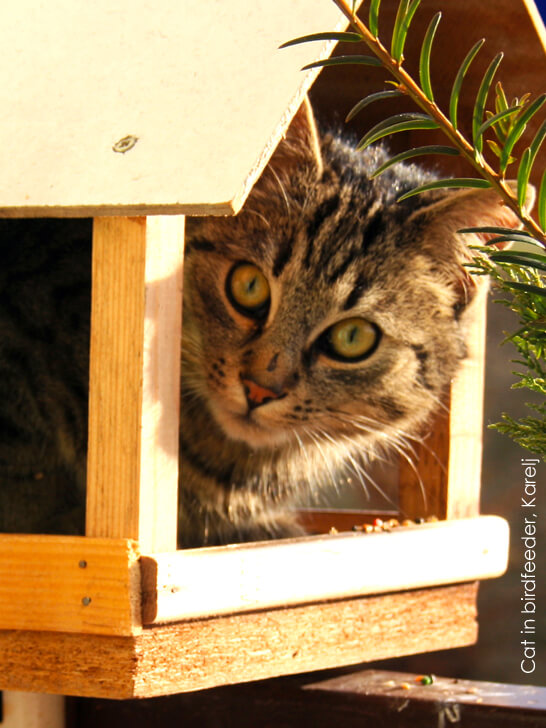Report from Gov't of Canada Echoes U.S. Finding: Outdoor Cats are Leading Human-Caused Source of Bird Mortality
 |
(Washington, DC, October 1, 2013) A new study from the government of Canada that looked at more than 25 human-caused sources of bird mortality has found that domestic cats, both feral and owned, are the leading lethal threat to birds in the country.
The study found that the median estimate of cat-caused mortality—almost 200 million bird deaths per year—was about six times greater than the next leading mortality estimate of about 32 million attributed to car collisions. The third-leading cause was collisions with buildings or homes, with a rate of about 22 million bird deaths per year.
“We synthesized estimates of the magnitude of human-related mortality in Canada from major industrial sectors and non-industrial or public activities that we believe kill substantial numbers of birds,” the report says. Some of the bird-mortality sources in addition to the top three included: transmission line collisions, wind energy, mining, forestry, and pesticides used in agriculture.
“A wealth of scientific studies in the United States have sounded the alarm about bird and other wildlife mortality from cats. Those studies have also voiced strong concerns about potential human health impacts. This Canadian national study continues a warning trend about this growing invasive species disaster that is at our doorstep in the form of outdoor cats,” said Grant Sizemore, Cats Indoors Program Manager for American Bird Conservancy, a leading bird conservation group in the United States.
The Canadian study says that several billion birds from over 400 species breed each year in Canada in a wide variety of habitats, but shorebirds, grassland birds, and aerial insectivores in particular have experienced rapid declines. Some of those declines are attributed to human-driven habitat change and mortality across North America over the past 40 years.
The study highlights the susceptibility of particular bird groups to certain mortality sources, such as the vulnerability of long-distance or nocturnal migrating birds to collisions with towers and buildings or of auks to be killed as bycatch in fisheries' gillnets.
Sizemore said that domestic cats are a non-native species in North America and are efficient, instinctive predators. Research by scientists from the Smithsonian Conservation Biology Institute and the U.S. Fish and Wildlife Service recently estimated that 114–164 million feral and owned outdoor cats in the U.S. are responsible for the deaths of 1.4–3.7 billion birds and 6.9–20.7 billion mammals every year. Even the mere presence of cats in the environment has been shown to reduce bird reproductive output and survivorship.
“Cats on the streets lead harsh and traumatic lives,” said Sizemore. The American Veterinary Medical Association (AVMA) has estimated that feral cats have an average lifespan of only two years, whereas owned cats average 10 years. Reasons for this reduced life expectancy include attacks by dogs and other feral cats, predation, being hit by cars, ingestion of poison, disease, and more.
Although some “humane” organizations seek to maintain cats outdoors, numerous state agencies, professional societies, and nonprofit organizations understand that doing so is detrimental to cats, wildlife, and people. For example, the AVMA's Committee on Environmental Issues has stated that “managed cat colonies do not solve the problems of cat overpopulation and suffering, wildlife predation, or zoonotic disease transmission.”
Consequently, the committee “strongly supports and encourages humane elimination of feral cat colonies” and “opposes passage of local or state ordinances that legalize the maintenance of managed [commonly called Trap, Neuter, Release, or TNR] cat colonies.”
People for the Ethical Treatment of Animals (PETA) also vigorously opposes TNR, taking the position that it is inhumane for the cats as well as the wildlife they hunt, injure, and/or kill.
According to scientists from the Centers for Disease Control and Prevention, cats are consistently the number-one carrier of rabies among domestic animals and pose a “disproportionate risk for potential human exposure.” Domestic cats are also the necessary host for the parasite that causes toxoplasmosis to complete its life cycle; each infected cat may shed hundreds of millions of the infectious parasite in its feces. In people, toxoplasmosis has been linked to schizophrenia, Alzheimer's disease, obsessive-compulsive disorder, and other neurodegenerative diseases. It can also cause sudden abortion and fetal abnormalities in pregnant mothers.


















































